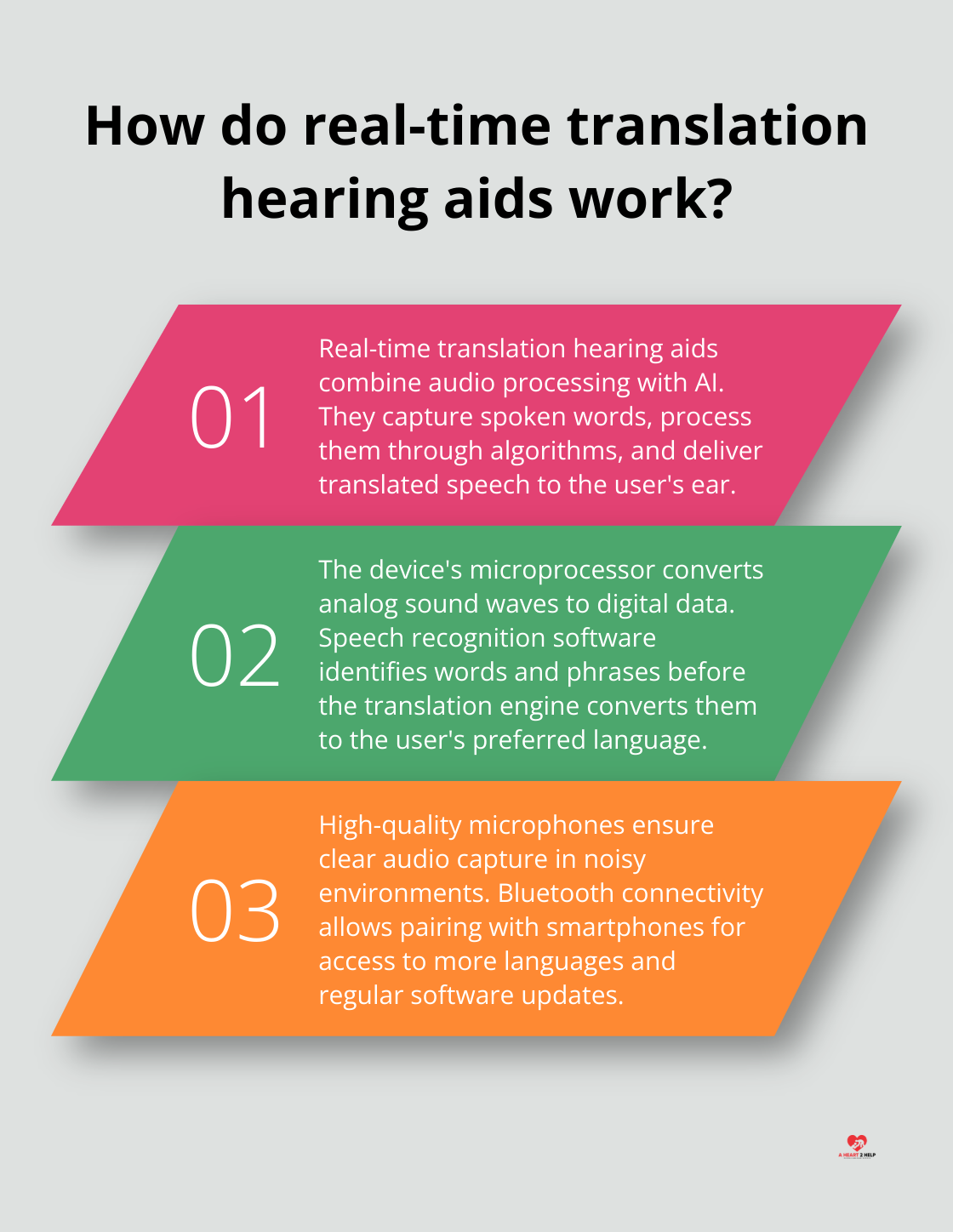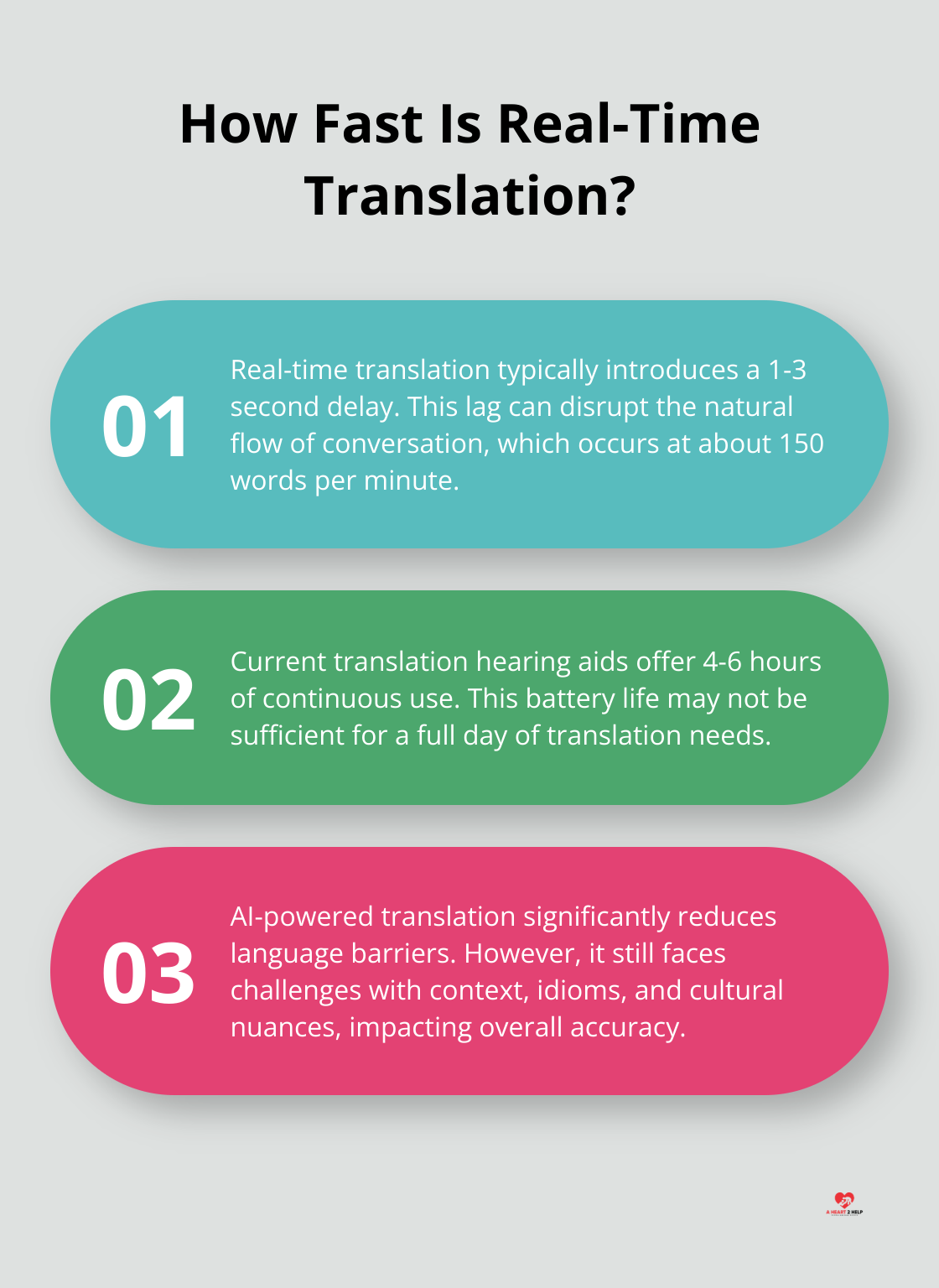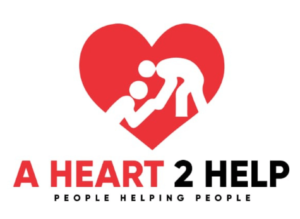At A Heart 2 Help, we’re excited about a groundbreaking innovation: hearing aids that translate languages in real-time.
This technology is set to revolutionize communication across language barriers, offering new possibilities for travel, business, and cultural exchange.
In this post, we’ll explore how these devices work, their benefits, and the challenges they face.
How Real-Time Translation Hearing Aids Work
Real-time translation hearing aids represent a technological breakthrough, combining advanced audio processing with artificial intelligence to overcome language barriers. These devices capture spoken words, process them through complex algorithms, and deliver translated speech directly to the user’s ear.
The Translation Process
The core of these hearing aids contains a powerful microprocessor that handles multiple tasks simultaneously. When someone speaks, the device’s microphones capture the sound waves. The processor then converts these analog signals into digital data. This digital information undergoes rapid analysis using speech recognition software to identify the words and phrases.

After speech recognition, the data travels to a translation engine. This engine (powered by machine learning algorithms) converts the original language into the user’s preferred language. The translated text then transforms back into speech using text-to-speech technology. Finally, the translated audio plays through the hearing aid’s speakers, allowing the user to understand the conversation in real-time.
Key Components and Features
Modern translation hearing aids pack cutting-edge components. High-quality microphones ensure clear audio capture, even in noisy environments. Powerful processors manage the complex computations required for translation. Some models include noise-cancellation technology to filter out background sounds, improving translation accuracy.
Many devices offer Bluetooth connectivity, allowing users to pair their hearing aids with smartphones. This enables access to a wider range of languages and regular software updates to improve performance. Some advanced models even incorporate biometric sensors to track the user’s health metrics (e.g., heart rate, steps taken), adding value beyond just translation capabilities.
AI and Machine Learning Advancements
The rapid progress in AI and machine learning has made real-time translation hearing aids a reality. Neural networks power the translation engines. These networks continuously learn and improve, adapting to different accents, dialects, and colloquialisms.
Machine learning algorithms also help personalize the user experience. They can learn individual speech patterns and preferences, fine-tuning translations for better accuracy over time. Some systems even use contextual understanding to provide more natural and nuanced translations, moving beyond literal word-for-word conversion.
As AI technology continues to advance, we can expect even more impressive features in future models. From understanding complex idiomatic expressions to adapting to specialized vocabularies in professional settings, the potential for improvement remains vast. These ongoing developments promise to make real-time translation hearing aids an increasingly powerful tool for global communication.
The next chapter will explore the numerous benefits and applications of this groundbreaking technology, showcasing how it transforms everyday life, travel experiences, and international relations.
Transforming Global Communication
Bridging Everyday Language Gaps
Real-time translation devices reshape interactions across linguistic boundaries, but they are still prone to errors and may struggle with certain accents or dialects. Additionally, they lack the cultural context necessary for fully nuanced communication. In multicultural cities, these devices prove invaluable. Users can converse effortlessly with non-English speaking neighbors about community events or understand specials at local ethnic restaurants without translation apps. For healthcare, patients now communicate symptoms and concerns directly to doctors who speak different languages, potentially improving diagnosis accuracy and treatment outcomes.
Revolutionizing Travel Experiences
For travelers, these devices act as game-changers. They eliminate the need for phrasebooks and struggles with local dialects. Users navigate foreign cities confidently, order meals, and engage with locals on a deeper level. The World Tourism Organization encourages the dissemination of its work and considers permissions, licensing, and translation requests related to its publications. Translation hearing aids could potentially boost tourism in less-visited regions and foster cultural understanding.
Transforming International Business
In the business world, real-time translation hearing aids level the playing field. Small businesses now compete globally without costly interpreters. International negotiations become smoother, reducing misunderstandings and accelerating deal-making processes. An Economist Intelligence Unit report revealed that 64% of executives believe language barriers hinder international growth. These devices directly address this challenge, potentially unlocking new markets and partnerships.
Enhancing Education and Cultural Exchange
In educational settings, these hearing aids open doors for international students and facilitate more diverse classrooms. Language exchange programs become more immersive and effective when participants understand each other instantly. Cultural nuances and idioms (often lost in traditional translation) can be better conveyed, leading to richer cross-cultural experiences.

The impact of real-time translation hearing aids extends beyond mere convenience. They foster empathy, understanding, and global citizenship. As these devices evolve, their potential to create a more connected world grows. However, with great technological advancements come challenges. The next chapter will explore the hurdles these devices face and the ongoing efforts to overcome them.
Navigating the Challenges of Translation Technology
The Accuracy Dilemma
Translation accuracy remains a primary concern for real-time translation hearing aids. AI has made significant progress, but it still faces difficulties with context, idioms, and cultural nuances. This example highlights how AI can accelerate hearing aid algorithm development by enabling rapid, cost-effective testing of new algorithms. However, challenges remain in achieving perfect accuracy, especially for complex sentences.

Users can take these steps to mitigate accuracy issues:
- Speak clearly and use simple language when possible
- Stay alert to potential misunderstandings, especially in critical conversations
- Use visual cues and gestures to supplement verbal communication
Processing Speed and Latency Issues
Real-time processing speed and latency can disrupt the natural flow of conversation. The average human speaks at about 150 words per minute, but current translation technologies often introduce a delay of 1-3 seconds. This lag can make conversations feel disjointed and unnatural.
To address this challenge:
- Exercise patience and allow for pauses in conversation
- Use shorter sentences to give the device time to process
- Prepare to repeat or rephrase if necessary
Battery Life Limitations
Battery life and power consumption pose significant challenges for these devices. Most current models offer 4-6 hours of continuous translation, which may not suffice for a full day of use. This limitation can create problems for travelers or professionals in international settings.
Users can overcome this issue by:
- Carrying portable chargers or spare batteries
- Planning strategic charging breaks throughout the day
- Using the translation feature selectively to conserve power
Privacy and Data Security Concerns
As with any internet-connected device, privacy and data security are paramount concerns. These devices process and transmit sensitive conversation data, raising questions about data storage, encryption, and potential vulnerabilities to hacking.
To protect privacy, users should:
- Research the data policies of device manufacturers before purchasing
- Use secure Wi-Fi networks when possible
- Exercise caution when sharing sensitive information in public spaces
Future Improvements
While these challenges are significant, they are not insurmountable. Technology continues to evolve, and we expect to see improvements in accuracy, speed, battery life, and security measures. The potential benefits of breaking down language barriers far outweigh these current limitations. Real-time translation with AI significantly reduces language barriers, enabling seamless communication between individuals who speak different languages.
Final Thoughts
Real-time language translation hearing aids will reshape global communication. These devices break down barriers that have long separated people of different linguistic backgrounds, opening up new possibilities for connection and understanding. The technology behind these hearing aids continues to evolve, with future iterations likely to offer improved accuracy, faster processing speeds, and longer battery life.

The impact of hearing aids that translate language in real-time extends far beyond individual convenience. These devices have the power to foster greater global understanding and cooperation in business, education, diplomacy, and cultural exchange. It’s not hard to imagine a world where language differences no longer hinder the free flow of ideas and information.
At A Heart 2 Help, we’re excited about the potential of real-time translation hearing aids to create more inclusive and connected communities. These devices can bring the world closer by eliminating language barriers (much like our app brings people together to offer and receive help). The future of communication is here, and it speaks every language.

